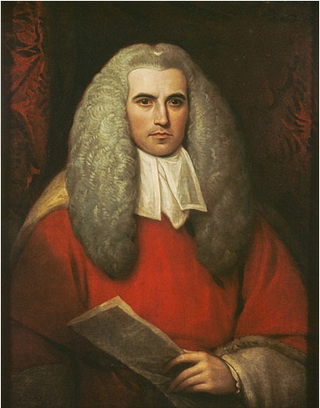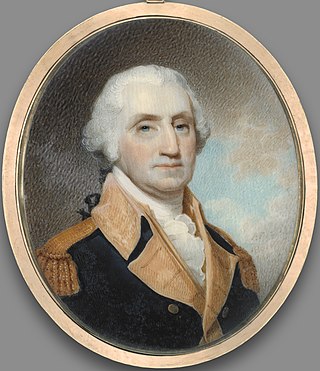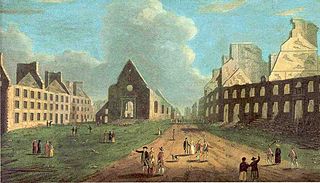
William Valentine (1798-1849) was a portrait painter and daguerreotypist in Halifax, Nova Scotia.

William Valentine (1798-1849) was a portrait painter and daguerreotypist in Halifax, Nova Scotia.
Born in 1798 in Whitehaven, England, he migrated to Halifax in 1818. [1] In 1822 he married Susannah Smith there, with whom he had two daughters. He married again in 1830 to Sarah Sellon. He died on December 26 in 1849 and was buried at Camp Hill Cemetery, Halifax.
From 1819 he worked as a portrait painter, teacher, and painter of signs and architectural ornaments. [2] In his early career, Valentine also worked as a house painter in periods that saw less commissions. [3] He filled a void left by portrait painter Robert Field who had practiced in Halifax from 1808 to 1816. Valentine painted his subjects in a naturalistic, plain style distinct from that of contemporary European portraitists. [3] His portraits often featured black-clad sitters against dark backgrounds. [3]
Valentine studied painting in England in 1836, after which his work visibly improved. [2] In 1839 he travelled to Paris where he learned the Daguerreotype process, an early form of photography, of which he was a pioneer in Canada as early as 1842. [2] Valentine was a mentor and later a business partner of the photographer Thomas Coffin Doane. [4]
In the 1830s and '40s he apparently worked in various places in Atlantic Canada, as evidenced by advertisements placed in Charlottetown, Saint John, and St. John's. [1]
His main interest was in portraits, of which he painted about 125-150. [1] The included many notaries of the day, including Thomas Chandler Haliburton, [5] Alexander Keith and William Black. Although some paintings were destroyed in a studio fire shortly before his death, many of his works are preserved at the National Gallery of Canada, the Library and Archives Canada, the New Brunswick Museum, and the Art Gallery of Nova Scotia.

Mary Frances Pratt, D.Litt was a Canadian painter known for photo-realist still life paintings. Pratt never thought of her work as being focused on one subject matter: her early work is often of domestic scenes, while later work may have a darker undertone, with people as the central subject matter. She painted what appealed to her, being emotionally connected to her subject. Pratt often spoke of conveying the sensuality of light in her paintings, and of the "erotic charge" her chosen subjects possessed.

Arthur Lismer, LL.D. was an English-Canadian painter, member of the Group of Seven and educator. He is known primarily as a landscape painter and for his paintings of ships in dazzle camouflage.
William Edward deGarthe (1907–1983) was a Finnish painter and sculptor who lived for much of his life in Peggy's Cove, Nova Scotia.

Maud Kathleen Lewis was a Canadian folk artist from Nova Scotia. She lived most of her life in poverty in a small house in Marshalltown, Nova Scotia. She achieved national recognition in 1964 and 1965 for her cheerful paintings of landscapes, animals and flowers, which offer a nostalgic and optimistic vision of her native province. Several books, plays and films have been produced about her. She remains one of Canada's most celebrated folk artists. Her works are displayed at the Art Gallery of Nova Scotia, as well as her restored house, whose walls she adorned with her art.

Sir Thomas Andrew Lumisden Strange was a chief justice in Nova Scotia, known for waging "judicial war" to free Black Nova Scotian slaves from their owners. From 1789 to 1797, he was the sixth Chief Justice of Nova Scotia. He became the first Chief Justice of the erstwhile Supreme Court of Madras and in that capacity was also the first Chief Justice of the Madras Presidency, British India from 1801 to 1817.
Cliff Eyland was a Canadian painter, writer and curator.

Sir Brenton Halliburton was the eighth Chief Justice of the Supreme Court of Nova Scotia.

John O'Brien (1831–1891) was a Canadian marine artist. He excelled at ship portraits combined with dramatic storm scenes.
Canadian art refers to the visual as well as plastic arts originating from the geographical area of contemporary Canada. Art in Canada is marked by thousands of years of habitation by Indigenous peoples followed by waves of immigration which included artists of European origins and subsequently by artists with heritage from countries all around the world. The nature of Canadian art reflects these diverse origins, as artists have taken their traditions and adapted these influences to reflect the reality of their lives in Canada.

Forshaw Day (1831–1903) was a Canadian artist known for his landscapes.

Robert Field (1769–1819) was a painter who was born in London and died in Kingston, Jamaica. According to art historian Daphne Foskett, author of A Dictionary of British Miniature Painters (1972), Field was "one of the best American miniaturists of his time." During Field's time in Nova Scotia at the beginning of the nineteenth century, he was the most professionally trained painter in present-day Canada. He worked in the conventional neo-classic portrait style of Henry Raeburn and Gilbert Stuart. His most famous works are two groups of miniatures of George Washington, commissioned by his wife Martha Washington.

Alice Mary Hagen was a Canadian ceramic artist from Halifax, Nova Scotia. She was trained in china painting, and earned her living through selling painted chinaware and teaching. She was among the artists selected to paint plates for the 1897 Canadian Historical Dinner Service. She gained a high reputation for the quality of her work, for which she won various prizes. She married happily and had two daughters. She continued to paint china while raising her family in Canada and Jamaica. When she was about sixty and her husband had retired she learned to make pottery at her studio in Nova Scotia, and was a pioneer of studio pottery in the area. She continued to produce and sell painted pottery until she was aged 93. Many ceramic artists acknowledged their debt to Alice Hagen as a teacher and an example.

Susanna Heller was a painter, who lived and worked in Brooklyn, New York. Born in New York City and raised in Montreal, she studied art in Halifax, Nova Scotia. She was a landed immigrant in Canada until 2006. She exhibits her work regularly in New York and in Toronto. She is known equally in Canada and the United States for her contributions to contemporary art as a painter. Her work is most well known for depictions of cities, primarily New York City.
Douglas Walker is a Canadian painter living and working in Toronto, Ontario.
Mary Marguerite Porter Zwicker was a Canadian artist and art promoter from Halifax, Nova Scotia. Known for her watercolor paintings of landscapes and villages in Nova Scotia, Zwicker exhibited her work at the Royal Canadian Academy of Arts, the Montreal Art Association, and the Art Gallery of Nova Scotia. Together with her husband, Leroy Zwicker, she owned and operated Zwicker's Gallery; for most of the 20th century, Zwicker's Gallery was the only Halifax gallery that routinely held art exhibits open to the public. It still operates.

Maria Morris Miller (1813–1875) was a Canadian artist from Halifax, Nova Scotia who is known for her botanical paintings and illustrations. She presented her work to Queen Victoria and received royal patronage for life. She is also the first professional woman artist in Nova Scotia, recognized in her field during her active career years. She worked with scientists and government officials, garnering her accolades as the "Audubon of Nova Scotian field flowers".

Richard Short was a military artist, best known for sketches he made of Quebec City, shortly after its capture by British forces. The appearance of many of the old French régime's principal buildings are known only from Short's sketches. He is also known for his sketches of Halifax, Nova Scotia, and notable naval engagements of the times.

John Hall is a Canadian modernist painter from Alberta, known for his highly realistic painting style.
Michael Adamson is a Canadian painter, photographer and curator who is primarily known for a style that blends landscape with abstraction but abstraction wins.
Joe Norris was a Canadian folk artist who painted images of his environment in Lower Prospect, Nova Scotia and places he learned about through television in crisp shapes, strong design and bright colour. He created wall paintings and painted furniture as well as models of villages, boats and lighthouses. In 2000 Bernard Riordon, the director of the Art Gallery of Nova Scotia, called him one of the greatest folk artists in Nova Scotia, a "Nova Scotia icon and a national treasure". Another museum director, Bruce Ferguson, in 1978, called him "the Matisse of folk art".
{{cite book}}: CS1 maint: date and year (link)